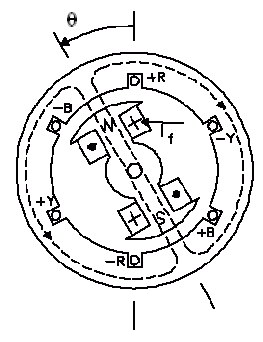How synchronous motor is used for power factor correction?
Answer:
Synchronous motors show some interesting properties, which find applications in power factor correction. The synchronous motor can be run at lagging, unity or leading power factor. The control is with the field excitation, as described below:
· When the field excitation voltage is decreased, the motor runs in lagging power factor. The power factor by which the motor lags varies directly with the drop in excitation voltage. This condition is called under-excitation.
· When the field excitation voltage is made equal to the rated voltage, the motor runs at unity power factor.
· When the field excitation voltage is increased above the rated voltage, the motor runs at leading power factor. And the power factor by which the motor leads varies directly with the increase in field excitation voltage. This condition is called over-excitation.
· The most basic property of synchronous motor is that it can be use as a CAPACITOR OR INDUCTOR both. Hence in turn it improves the power factor of system.
The leading power factor operation of synchronous motor finds application in power factor correction. Normally, all the loads connected to the power supply grid run in lagging power factor, which increases reactive power consumption in the grid, thus contributing to additional losses. In such cases, a synchronous motor with no load is connected to the grid and is run over-excited, so that the leading power factor created by synchronous motor compensates the existing lagging power factor in the grid and the overall power factor is brought close to 1 (unity power factor). If unity power factor is maintained in a grid, reactive power losses diminish to zero, increasing the efficiency of the grid. This operation of synchronous motor in over-excited mode to correct the power factor is sometimes called as Synchronous condenser.
…………………………………………
What is hunting in synchronous machine?
Answer:
In the process of hunting when a DC generator(alternator) is subjected to a sudden change in load(in the stator) causes the rotor to hunt for a new equilibrium position(let us take the example of a pendulum when its made to oscillate with a general push it oscillate with a particular amplitude and frequency and after its oscillation, reaches the mean position, but as a certain load say 2gms is applied to the pendulum, oscillation changes and pendulum tries to attain a new amplitude and frequency as the applied load suggests)similarly in the case of alternator as the load changes rotor attains a new equilibrium position say of a particular degree(z)and the degree of rotation changes from(0 to 360 previously to 0+z to 360+z degrees with a new changed position)which refers to hunting in general sense.
Always remember in an alternator stator consists of armature windings and rotor consists of field windings and the main field flux is produced in the field windings(just opposite the case in an induction motor).

